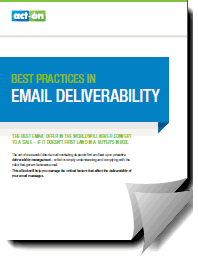We’ve all been here: You’ve spent lots of time crafting, tweaking, and creating the perfect email message to your subscribers, in hopes that you will  be able to entice them to greater engagement with a new product offering, service, or note about your organization. Your email is ready to go. You get your lists in order, your cadence set, and your team ready for responses. Then the email goes out – and suddenly you are getting word that your recipients didn’t get your message. So what actually happens when the mail doesn’t arrive?
be able to entice them to greater engagement with a new product offering, service, or note about your organization. Your email is ready to go. You get your lists in order, your cadence set, and your team ready for responses. Then the email goes out – and suddenly you are getting word that your recipients didn’t get your message. So what actually happens when the mail doesn’t arrive?
This is a very common issue that can come up in the realm of deliverability. But what causes it? And how can you take steps to ensure that your messages are getting read once they are sent?
Let’s begin at the beginning. Your campaign is ready and you hit the send button. Many marketers believe that once you hit “send” that the message goes directly to the recipient right away. This isn’t the case; there are a series of servers, gates, and steps that come between your email and your intended receiver.
Your email’s path to your recipient
When you hit “send,” many email service providers (ESPs) and marketing automation companies will first bounce the lists you are sending to up against your own suppression lists (opt-outs, hard bounces, blocked domains) as well as the ESP’s own global suppression files (yes, they have such things). Once that shake-out has been completed, your email is then sent to the mail transfer agent (MTA) to be sent to the receiving servers of the clients you are trying to reach.
Once the mail has made its way through the MTA, it next goes through an inbound mail gateway. Google describes this well: “A server through which all incoming mail for the receiving domain passes. The gateway typically processes the mail in some way – such as archiving it or filtering out spam — then passes the mail on to the next mail server.”
This next email server is the one that actually delivers the messages to the recipients. As the mail gets passed along to the post-gateway mail server, still more filters can come into play, such as organizational or individual filters. At each point it is possible for your mailing to get “dropped on the floor’ – which means that your message did not bounce, but may not have been received by the end user. Gateways can use spam appliances and organizations can have quarantine boxes; either could trip up your email. It’s also possible that individuals could have you on their block list.
No guarantees
There is no guarantee that all mail sent out will get delivered 100% of the time. That is just the nature of the deliverability beast. You may see that  while your messages are sent and delivered, you can also encounter issues such as bounces, either spam-related or policy-related. This is due to the spam filtering that most ISPs and domains have in place to help prevent the transmission of spam and irrelevant emails. Even if you have engaged recipients, your emails may be caught in these filters due to factors such as IP reputation, content, or the fact that other users have reported spam complaints on your emails.
while your messages are sent and delivered, you can also encounter issues such as bounces, either spam-related or policy-related. This is due to the spam filtering that most ISPs and domains have in place to help prevent the transmission of spam and irrelevant emails. Even if you have engaged recipients, your emails may be caught in these filters due to factors such as IP reputation, content, or the fact that other users have reported spam complaints on your emails.
Additionally, some mailings may go straight to the junk, promotional, and/or spam folders. Some recipients may just not be looking in all mail folders and are therefore missing your mail – and the opportunity to mark you as a trusted sender. (When a recipient marks you as a trusted sender, every email you send them from that same trusted sending address will go straight to the inbox. )
5 Best Practices for Email Deliverability
So what can you do to help your email get delivered past these hurdles? Here are a few tips:
- Make sure your emails contain information that is relevant to your recipients. Start by segmenting your lists by meaningful factors, such as location, interests, industry, previous products purchased, and so on. Then create messaging that acknowledges and addresses those factors. If every time they open your email they find something that feels like it’s personalized to them, you’ll get more engagement.
- Segment also by degrees of engagement. Engaged recipients are those who have clicked or opened an email in the last 90–180 days, and are typical responders. The “unengaged” are new prospects, or those who have not acted yet.
It’s a good practice to send the message to your engaged segment a few hours before you send to the unengaged. As they engage, this helps demonstrate to the ISPs that this is wanted email. That can make it easier for the next batch (the unengaged) to be moved along.
- Do one more check for content that might catch the notice of a spam filter. Special characters, lots of ALL CAPS, low-quality links, or emails that are all image and no text can make your email snag on various filters along the way to the inbox.
- Ask your recipients to add you to their Safe Senders list. Make it very easy, Here’s sample language you could adapt:
Want to keep receiving our emails? Just add our “From” address to your Safe Senders list, OR add us to your address book or contact list to continue receiving the wonderful offers we send to you.
- Make sure all your recipients are fully opted in. If someone already gave consent to get your emails, your odds of getting marked as spam go way down, as ISPs notice that your messages are trusted and wanted.
If you are still unable to get into your engaged recipient’s mailbox after using these steps – there may be a chance that your recipients will need to talk to their mail administrator. There could be extra filters, rules, or steps that are preventing your messages from getting in. If a recipient will contact their IT team regarding a delivery issue, there’s a higher chance of success than having to remediate from the outside-in.
Deliverability will always be a game of trial and error. If you see challenges getting your mails read, follow these steps and try different approaches to see what works and what mailings are most successful in reaching the inbox. Over time, with good practices and sending habits, the chances of your mailings going straight to the inbox will increase and your  recipients will be more engaged with your offerings and business as a whole.
recipients will be more engaged with your offerings and business as a whole.
For more tips and tricks on how to manage the critical factors that affect the deliverability of your email messages, check out “Best Practices in Email Deliverability.” This eBook will help you learn the key factors that affect your sender reputation, how to avoid SPAM filters and so much more.
